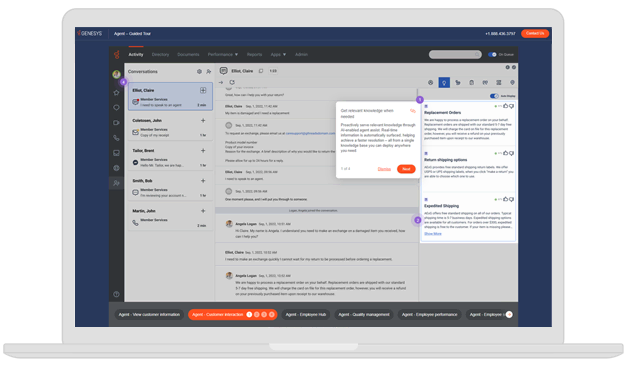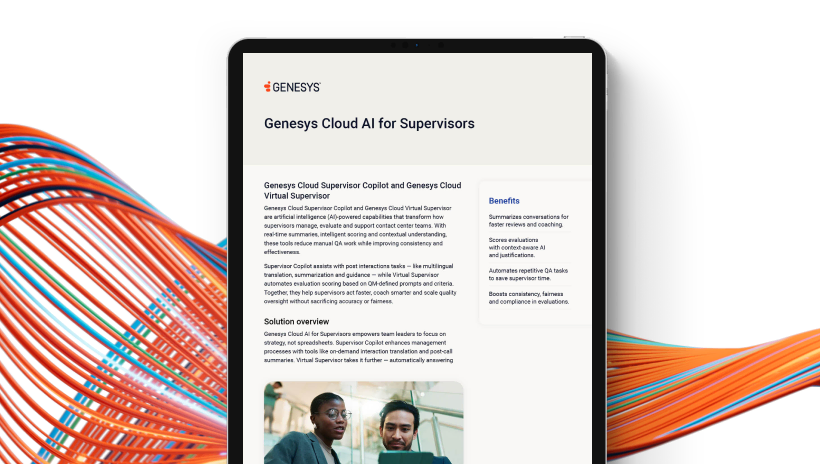
Absences and shrinkage are inevitable parts of managing your contact center workforce. But approaching each strategically can minimize their negative effects. Here’s how you can control shrinkage and absences for a healthier call center environment.
The cost of absenteeism and shrinkage in customer service operations
Shrinkage and absence can cost your contact center and your business. Both impact the number of agents you need to schedule at a given time to maintain service levels. Absent workers, whether it’s just a day off or it’s a skipped shift, mean less capacity for work.
The same goes for shrinkage, whether it stems from something important like team meetings, training, a break or an agent is just slow getting from one call to the next.
Either way, less capacity for work means less work gets done — fewer customer inquiries are answered, and fewer issues get resolved.
Additionally, shrinkage and absence can cost you in terms of brand reputation and sheer dollars and cents. When you can’t cover all necessary shifts, that can lead to missed service levels, delayed responses, and ultimately, negative customer and employee experiences. And when an agent has to stay late or work overtime to cover for an unavailable agent, that costs money. Even small breakdowns can ripple out and impact both CX and operational efficiency.
Aligning workforce planning with business goals
Aligning contact center workforce planning with business goals requires integrating strategic objectives into staffing decisions. This includes forecasting call volumes based on marketing or product initiatives, aligning staffing levels with customer experience goals and using performance metrics that reflect business outcomes like customer satisfaction and retention.
Collaboration between workforce planners and leadership helps to ensure resource allocation can support growth, efficiency and service quality. Flexibility in scheduling and leveraging data analytics can also help to align workforce capacity with evolving business demands.
Effective absence- and shrinkage-reduction tactics
There are several effective tactics that can be used to reduce and track shrinkage and absenteeism. We’ll go into more detail on each later, but some of the most helpful are:
- Implementing flexible scheduling
- Promoting employee wellness programs
- Enhancing managerial support and engagement
- Training for attendance and accountability
- Rewarding positive attendance behavior
- Conducting return-to-work interviews and root-cause analysis
- Building a predictive model for absentee risk
It’s important to note that while these tactics can help adjust agent behaviors, nothing is 100%. Shrinkage and absence will never drop to zero — nor should they, really. Plan for variability and risk; for instance, by building in higher shrinkage or attrition cushions.
Understanding absence management in call centers
Let’s look at what absence management is, how absence management differs based on type, and how managers and HR play a role in attendance.
What constitutes absence management?
Absence management in a contact center involves monitoring, recording and managing employee absences to maintain operational efficiency and service levels. It includes tracking various types of leave and helping to ensure compliance with company policies and labor regulations.
Effective absence management uses workforce management tools to forecast staffing needs and adjust schedules in real time to help minimize service disruptions. It also involves analyzing absence patterns to identify trends, address potential issues (like burnout or disengagement) and implement proactive measures such as wellness programs or flexible scheduling. Clear communication, proper documentation and manager training are key components to provide for fairness and consistency across the team.
Types of absences: planned vs. unplanned, paid vs. unpaid
Not all absences are created equal. There are a few different types, and managers tend to treat each differently. For example, a planned absence like scheduled PTO can be easy to manage, because managers can bake it into the schedule ahead of time. Coverage for the absent worker is a lot harder to find on short notice, as in an unplanned absence like a sick day.
The distinction between a paid and unpaid absence can be a bit more subtle. There is some overlap. For instance, a planned absence like vacation is usually paid, and an unplanned absence like a no-call no-show is usually unpaid.
That said, if an employee takes a planned day off without PTO to cover it, it might be unpaid; and an unplanned day off like a sick day is typically paid. This can depend on the business.
The role of HR and workforce managers in monitoring attendance
HR is responsible for developing and enforcing attendance policies, maintaining accurate records, and addressing chronic absenteeism through corrective actions or support programs. Workforce managers, on the other hand, focus on real-time attendance tracking, schedule adherence, and helping to ensure adequate staffing levels. They use workforce management systems to identify attendance gaps and make responsive adjustments to mitigate service disruption.
Both roles collaborate to analyze attendance trends, support employee engagement, and implement strategies to reduce absenteeism, such as wellness initiatives or flexible scheduling. Their joint efforts help to create a productive, well-staffed environment aligned with business goals.
Why is managing absence crucial for call centers?
Without absence management, it’s nearly impossible for your contact center to function properly. Here’s why.
Impact on service-level agreements (SLAs) and key metrics
Absenteeism can have a major impact on your contact center’s ability to work smoothly. Unexpected understaffing can hamstring a contact center for a day or more, unless managers can find coverage. Service levels drop, and key metrics can become impossible to reach. In short, employees need to be present in order for work to get done.
Agent morale and team performance
When employees are frequently absent, their workload often shifts to colleagues, which can lead to increased stress, burnout and frustration. This imbalance can create resentment and reduce team cohesion.
Over time, consistent absenteeism may lower overall productivity, increase error rates and degrade service quality. Morale may suffer as engaged agents feel overburdened or undervalued, which may lead to higher turnover. Maintaining attendance is crucial for team stability, motivation and delivering consistent customer experiences.
The connection between absence trends and employee engagement
In a contact center, absence trends often reflect the level of employee engagement. High absenteeism may signal disengagement, burnout, job dissatisfaction or lack of support. When agents feel unmotivated or undervalued, they’re more likely to take unplanned time off.
Conversely, engaged employees tend to have lower absence rates due to higher commitment and job satisfaction. Monitoring absence trends helps managers identify underlying issues affecting morale and take proactive steps to boost engagement and improve attendance.
Understanding the ripple effect on shrinkage
When agents are absent, available staff must handle more calls, increasing stress and reducing performance. This can lead to burnout or disengagement, potentially raising future absenteeism and turnover. Similarly, scheduling multiple agents for training at once reduces real-time coverage, leading to longer wait times and lower service levels. These compounded impacts can strain resources, degrade customer experience and make it harder to maintain staffing balance, ultimately affecting overall efficiency and employee morale.
Strategies to reduce absence and shrinkage
How can management help to prevent both absences and shrinkage? There are a few strategies that a contact center can employ, including the following.
Implementing flexible scheduling
Provide flexibility where it matters to agents, without compromising the control WFM teams need to ensure coverage, consistency and performance. Giving your agents the ability to control their schedules — at least to an extent — can help reduce absenteeism issues. When agents choose when they work, they’re less likely to ask for a scheduled workday off. They can plan around doctor’s appointments, childcare responsibilities or any other of the myriad things that can disrupt a schedule.
Sometimes managers will still need to adjust schedules to account for over- or understaffing, but flexible scheduling can mitigate a lot of issues.
Promoting employee wellness programs
Employee wellness programs can reduce absenteeism and shrinkage by addressing the root causes of health- and stress-related absences. Wellness initiatives like mental health resources, fitness incentives and flexible scheduling help improve employees’ physical and emotional well-being.
When agents feel healthier, more supported, and less overwhelmed, they are more likely to attend work consistently and perform effectively. This not only lowers unplanned absences but also improves engagement, morale and retention, reducing overall shrinkage. A proactive wellness culture can foster a resilient workforce capable of maintaining high service levels and productivity.
Enhancing managerial support and engagement
When managers actively support their teams through regular check-ins, recognition, coaching and clear communication, employees may feel more valued, understood and motivated. Engaged managers can identify early signs of stress or dissatisfaction, allowing for timely interventions like schedule adjustments or resource support.
Strong managerial relationships also foster a sense of accountability and trust. This can make agents more likely to show up and stay engaged. A supportive environment like this can boost morale, reduce burnout and encourage commitment. All of this can help decrease unplanned absences and overall shrinkage.
Training for attendance and accountability
Training for attendance and accountability sets clear expectations and empowers employees to take responsibility for their work habits. Through structured onboarding and ongoing training, agents learn the importance of schedule adherence and their role in achieving team performance goals. Such training often includes understanding attendance policies, the impact of absenteeism on peers and customer service, and strategies for self-management.
When agents understand potential consequences and have the right tools, they’re more likely to maintain regular attendance.
Rewarding positive attendance behavior
Rewards can be powerful incentives for all employees, and call center agents are no exception. Incentives like recognition, bonuses, extra time off or public acknowledgment create a sense of appreciation. When employees see tangible rewards linked to good attendance, it may foster healthy competition and accountability. These programs can also boost morale and engagement, making agents more committed to their roles.
Conducting return-to-work interviews and root cause analysis
Conducting return-to-work (RTW) interviews and root cause analysis helps address underlying causes of absence. RTW interviews demonstrate managerial support and show employees that their attendance matters, potentially discouraging casual absences. These conversations also uncover personal or workplace issues that may be contributing to frequent absences.
Root cause analysis helps identify systemic problems like workload stress, health concerns or scheduling conflicts that affect attendance. By resolving these issues proactively, contact centers can improve employee well-being and maintain stronger workforce stability.
Building a predictive model for absentee risk
Contact centers can proactively identify likely absences based on historical data, behavior patterns and external factors. Analyzing indicators like attendance history, engagement scores, schedule adherence and workload helps managers take early, targeted actions like offering support, adjusting schedules or initiating wellness check-ins.
This predictive approach allows for better resource planning and reduces the element of surprise in staffing gaps. Ultimately, it helps decrease absenteeism and shrinkage by addressing potential issues before they impact operations and customer service.
Leveraging technology for effective absence management
There are many tools out there that can help make absence management easier and more efficient. Let’s take a look at a few features for these tools and how you can use them.
Key features of absence management software
Real-time agent attendance tracking, automated leave requests and approvals, and integration with workforce management systems are critical. Absence management software provides analytics and reporting tools to help identify absence trends and high-risk patterns.
Alerts and notifications help managers respond promptly to unplanned absences, while policy enforcement tools help to ensure compliance. Some platforms also offer self-service portals for employees, enabling transparency and accountability. These features collectively improve planning, reduce shrinkage, and enhance operational efficiency.
Integrating software solutions with existing systems
Integrating absence management software with existing systems can enhance operational efficiency by centralizing attendance data within workforce management, HR and scheduling platforms. This integration enables real-time updates on employee availability, supports automated scheduling adjustments and helps to ensure policy compliance. It reduces administrative overhead, improves forecasting accuracy and allows managers to make data-driven decisions more quickly. Seamless integration also enhances transparency for employees and strengthens coordination across departments, ultimately helping reduce absenteeism, shrinkage and service disruptions.
Using real-time dashboards and analytics to track trends
Real-time dashboards and analytics provide contact center managers with instant visibility into attendance patterns. This allows them to monitor absences by day, shift, team or individual. These tools help identify trends such as frequent absences, peak no-show periods or recurring issues across departments.
By visualizing data, managers can pinpoint root causes, predict future risks and implement timely interventions. This proactive tracking supports strategic workforce planning, which can reduce shrinkage and improve overall staffing stability and operational performance.
Automating alerts and notifications for policy violations
Automating alerts and notifications enables timely awareness and consistent enforcement of attendance rules. These real-time alerts help managers quickly address unplanned absences, late arrivals or excessive leave usage. Automation reduces manual tracking errors and helps to ensure managers don’t miss violations, fostering accountability. It also supports fair, transparent policy application, which enhances employee trust and compliance — ultimately contributing to reduced absenteeism, lower shrinkage and improved service reliability.
Leveraging AI to forecast shrinkage and optimize staffing
Rather than using a tool like an Erlang calculator, contact centers can leverage AI for capacity planning to avoid shrinkage as much as possible. AI can analyze historical data, attendance patterns, seasonality and external factors like weather or events. It uses shrinkage and attrition percentages to model future staffing needs and prepare for different scenarios. This allows managers to create optimized schedules with built-in buffers, minimizing understaffing risks.
AI can also adjust staffing in real time based on live data, improving responsiveness. By proactively anticipating shrinkage, contact centers can maintain service levels, reduce costs and enhance both agent and customer satisfaction.
Conclusion
Absenteeism and shrinkage both cost contact centers. But while neither is totally avoidable, you can mitigate the problems they pose. Don’t let scheduling issues damage the health of your contact center.
Learn more about improving CX teams’ performance with AI.
Frequently asked questions (FAQs)
What is shrinkage in a call center and how is it calculated?
Call center shrinkage is the portion of time a call center is paying agents, but they’re unavailable for handling customer interactions. Shrinkage can be due to activities like breaks, training or unplanned absences. You can calculate call center shrinkage with this formula:
Shrinkage (%) = (Total Non-Productive Time / Total Scheduled Time) × 100
How does absence management differ from shrinkage management?
Absence management focuses specifically on tracking and reducing employee absences, such as sick leave or unplanned time off. Shrinkage management is broader, encompassing all factors that reduce agent availability, including breaks, meetings, training and absences. Both aim to optimize staffing but address different aspects of workforce productivity.
What are typical shrinkage benchmarks for call centers?
Typical shrinkage benchmarks for call centers range from 30% to 35% for inbound centers. This can depend on factors like industry, hours of operation and call volume.
These benchmarks include both planned shrinkage (e.g., training, meetings) and unplanned shrinkage (e.g., absences, tardiness, longer breaks). They help guide realistic staffing and scheduling decisions.
Can absence management software really reduce shrinkage?
Absence management software can reduce shrinkage by providing real-time visibility into attendance, automating leave tracking and identifying absence patterns. It helps managers proactively address issues, enforce policies consistently and optimize scheduling. This leads to improved attendance, reduced unplanned absences and more accurate staffing, ultimately helping to lower overall shrinkage.
How do flexible schedules help with absence management?
Flexible schedules support absence management by accommodating employees’ personal needs, reducing stress and burnout — common causes of unplanned absences. When agents have more control over their work hours, they’re more likely to maintain regular attendance. This approach boosts morale, enhances work-life balance, and helps decrease absenteeism and related shrinkage.
What are the most common causes of unplanned absences in call centers?
Illness, family emergencies, mental health issues, burnout, job dissatisfaction and poor work-life balance can all cause unplanned absences. Stressful workloads, rigid schedules and lack of engagement can also contribute. Identifying these factors helps managers implement supportive policies and wellness programs to reduce absenteeism.
How can we identify patterns or trends in employee absence?
You can identify patterns in employee absence by analyzing attendance data using absence management software or HR analytics tools. Look for recurring absences on specific days, during certain seasons or following schedule changes. Visualization dashboards and reports help spot trends, enabling proactive management and targeted interventions.
What KPIs should we track to monitor absence and shrinkage effectively?
Key KPIs to monitor absence and shrinkage effectively include:
- Absenteeism rate
- Shrinkage percentage
- Schedule adherence
- Unplanned vs. planned absences
- Average handling time (AHT)
- Agent utilization rate
Tracking these metrics helps identify attendance issues, forecast staffing needs accurately and implement strategies to maintain service levels and productivity.
Is it better to manage shrinkage reactively or proactively?
Managing shrinkage proactively is more effective than reactive approaches. Proactive management anticipates staffing gaps through forecasting, real-time monitoring and preventive strategies like wellness programs and flexible scheduling. This helps to ensure better resource planning, maintain service levels and reduce operational disruptions. On the other hand, reactive management often leads to rushed adjustments, agent stress and customer dissatisfaction.






